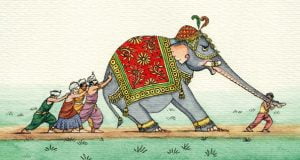The economy of India is a developing mixed moratorium. It is the world’s sixth-largest economy by nominal GDP and the third-largest by purchasing power parity. The country ranks 141st in per capita GDP (nominal) with $1723 and 123rd in per capita GDP (PPP) with $6,616 as of 2016.
After 1991 economic liberalisation, India achieved 6-7% average GDP growth annually. In FY 2015 and 2017, India’s economy became the world’s fastest-growing major economy surpassing China.
And now, India has gripped another hook into its corners- Our motherland is ranked second only to South Africa as the cheapest country to live or retire, according to a recent survey of 112 countries.
Nations were ranked on local purchasing power, rent, groceries, and consumer price index metrics. India is the lowest on maximum parameters has emerged as the most value-for-money country in the worldwide survey.

With the second lowest rent index among the 50 cheapest countries (after neighbour Nepal), living in India can be cheaper compared to most of the countries. Given that, the world rate is also on par with that of India, now our country is the second most economically feasible country to live in with a suitable standard of living.
India also has a relatively high local purchasing power in the major cities that were surveyed. India is cheaper than its neighbouring countries like Colombia ranked at 13, Pakistan (14), Nepal (28), Bangladesh (40).
On the other hand, South Africa has topped the survey as the cheapest country to live or retire.
Also, there has been an industry-wide survey per country and here are the details for India:

Petroleum products and chemicals
Petroleum products and chemicals are a major contributor to India’s industrial GDP, and together they contribute over 34% of its export earnings. India hosts many oil refinery and petrochemical operations, including the world’s largest refinery complex in Jamnagar that processes 1.24 million barrels of crude per day. By volume, the Indian chemical industry was the third-largest producer in Asia and contributed 5% of the country’s GDP. India is one of the five largest producers of agrochemicals, polymers and plastics, dyes and various organic and inorganic chemicals. Despite being a large producer and exporter, India is a net importer of chemicals due to domestic demands.
Pharmaceuticals
The Indian pharmaceutical industry has grown in recent years to become a major manufacturer of healthcare products to the world. India produced about 8% of the global pharmaceutical supply in 2011 by value, including over 60,000 generic brands of medicines. The industry grew from $6 billion in 2005 to $36.7 billion in 2016, a compound annual growth rate (CAGR) of 17.46%. It is expected to grow at a CAGR of 15.92% to reach $55 billion in 2020. India is expected to become the sixth-largest pharmaceutical market in the world by 2020. It is one of the fastest-growing industrial sub-sectors and a significant contributor of India’s export earnings. The state of Gujarat has become a hub for the manufacture and export of pharmaceuticals and active pharmaceutical ingredients (APIs).
Engineering
Mahindra XUV 500 is one of the several indigenously designed and manufactured vehicles
Engineering is the largest sub-sector of India’s industrial sector, by GDP, and the third-largest by exports.[167] It includes transport equipment, machine tools, capital goods, transformers, switchgear, furnaces, and cast and forged parts for turbines, automobiles and railways. The industry employs about four million workers. On a value-added basis, India’s engineering subsector exported $67 billion worth of engineering goods in the 2013–14 fiscal year and served part of the domestic demand for engineering goods.
Gems and jewellery
Many famous stones such as the Koh-i-noor and Hope Diamond (above), came from India.
India is one of the largest centres for polishing diamonds and gems and manufacturing jewellery; it is also one of the two largest consumers of gold. After crude oil and petroleum products, the export and import of gold, precious metals, precious stones, gems and jewellery accounts for the largest portion of India’s global trade. The industry contributes about 7% of India’s GDP, employs millions, and is a major source of its foreign-exchange earnings. The gems and jewellery industry, in 2013, created ₹251,000 crore (US$39 billion) in economic output on a value-added basis. It is growing sector of Indian economy, and A.T. Kearney projects it to grow to ₹500,000 crore (US$79 billion) by 2018.
Textile
Textile industry contributes about 4 percent to the country’s GDP, 14 percent of the industrial production, and 17 percent to export earnings. India’s textile industry has transformed in recent years from a declining sector to a rapidly developing one. After freeing the industry in 2004–2005 from a number of limitations, primarily financial, the government permitted massive investment inflows, both domestic and foreign. From 2004 to 2008, total investment into the textile sector increased by 27 billion dollars. Ludhiana produces 90% of woollens in India and is known as the Manchester of India. Tirupur has gained universal recognition as the leading source of hosiery, knitted garments, casual wear and sportswear.
Mining
India’s mining industry was the fourth-largest producer of minerals in the world by volume and eighth-largest producer by value in 2009. In 2013, it mined and processed 89 minerals, of which four were fuel, three were atomic energy minerals and 80 non-fuel. The government-owned public sector accounted for 68% of mineral production by volume in 2011–12.
Nearly 50% of India’s mining industry, by output value, is concentrated in eight states: Odisha, Rajasthan, Chhattisgarh, Andhra Pradesh, Telangana, Jharkhand, Madhya Pradesh and Karnataka. Another 25% of the output by value comes from offshore oil and gas resources. India operated about 3,000 mines in 2010, half of which were coal, limestone and iron ore.
Defence
With a strength of over 1.3 million active personnel, India has the third-largest military force and the largest volunteer army. The total budget sanctioned by the Indian military for the financial year 2017 was (US$53.5 billion). Defence spending is expected to rise to US$62 billion by 2022.
Aviation
India is the fourth-largest civil aviation market in the world recording an air traffic of 131 million passengers in 2016. The market is estimated to have 800 aircraft by 2020. In 2015, Boeing projected India’s demand for aircraft to touch 1,740, valued at $240 billion, over the next 20 years. This would account for 4.3 percent of global volumes. According to Airbus, India will be one of the top three aviation markets in the next 20 years. Airbus is expecting an annual growth rate of over 11 percent for the domestic market over the next ten years, while the combined growth rate for domestic and international routes would be more than 10 percent.
Banking and finance
The Indian money market is classified into the organised sector, comprising private, public and foreign-owned commercial banks and cooperative banks, together known as ‘scheduled banks’; and the unorganised sector, which includes individual or family-owned indigenous bankers or money lenders and non-banking financial companies.
The unorganised sector and microcredit are preferred over traditional banks in rural and suburban areas, especially for non-productive purposes such as short-term loans for ceremonies.
Financial technology
According to the report of The National Association of Software and Services Companies (NASSCOM), India has a presence of around 400 companies in the fintech space, with an investment of about $420 million in 2015. The NASSCOM report also estimated the fintech software and services market to grow 1.7 times by 2020, making it worth $8 billion. The Indian fintech landscape is segmented as follows – 34% in payment processing, followed by 32% in banking and 12% in the trading, public and private markets.
Information technology
The information technology (IT) industry in India consists of two major components: IT services and business process outsourcing (BPO). The sector has increased its contribution to India’s GDP from 1.2% in 1998 to 7.5% in 2012. According to NASSCOM, the sector aggregated revenues of US$147 billion in 2015, where export revenue stood at US$99 billion and domestic at US$48 billion, growing by over 13%.
Insurance
The Indian insurance business had been under-developed with low levels of insurance penetration. Post liberalisation, the sector has succeeded in raising penetration from 2.3 (life 1.8 and non-life 0.7) in 2000 to 5.1 (life 4.4 and non-life 0.7) in 2010.
India became the world’s third-largest producer of electricity in 2013 with a 4.8% global share in electricity generation, surpassing Japan and Russia.









